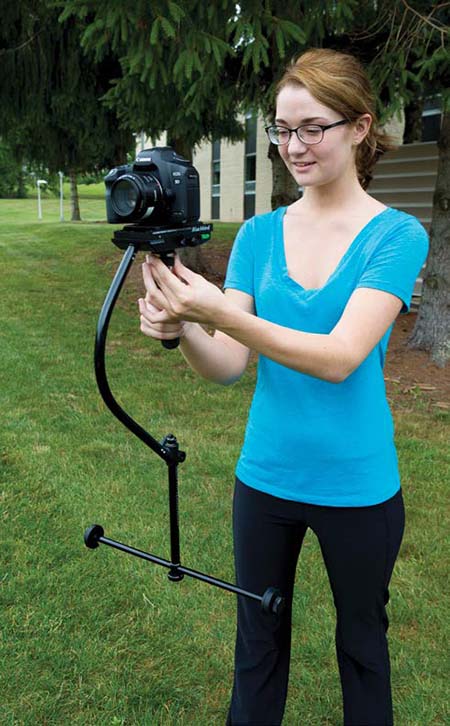CMR Blackbird Camera Stabilizer

The Camera Motion Research Blackbird motion stabilizer in use Camera Research Motion’s Blackbird camera stabilizer supports cameras up to eight pounds, helping shooters wade through the sea of gimbal stabilizers. Using the company’s “Smooth Touch” technology, the adjustable controlled friction keeps tilt and roll movements to a minimum, a problem with most stabilizing systems.
FEATURESbr />Like most handheld stabilizers, the Blackbird consists of a camera platform and mounting plate attached to a support arm housing the handle and gimbal. A T-bar with two differently-sized horizontal bars and counterweights support and balance the system.
If you’ve used a motion-stabilizing device then you know that the “pendulum effect” is something that requires some amount of “fight” to control. Fast starts or stops sometimes allow a stabilizer to keep on moving, much like the pendulum on a clock. The gimbal friction in the Blackbird (Smooth Touch) helps to reduce this pendulum effect and also eliminate wind movement when shooting outdoors (more on this later). This results in smoother shots, regardless of an operator’s skills.
As with any stabilizer, balancing is the key to optimal use of this unit. The Blackbird provides front and back adjustment via the camera plate and adjusting screws on the back and side. Adding or removing counterweights controls vertical balance while raising and lowering the T-bar fine tunes it. The unit includes 11- and 15-inch inch horizontal bars, with the longer bar providing better pan axis movement
The Blackbird itself weighs only 2.5-pounds, making it “lightweight” as stabilizers go. Its bubble levels show roll and tilt balance and help keep the unit level.
Although the Blackbird is easy to balance, first-time users will find the instruction manual helpful and straightforward, and the included DVD will streamline the learning curve.
IN USE
Our school’s equipment cage contains five different types of camera stabilizers, so when the Blackbird arrived, few students gave it a second look. The only major differences with most camera stabilizers are the type of weights used and how the units are mounted.
The professional video industry's #1 source for news, trends and product and tech information. Sign up below.
Before students tried out the Blackbird, I was fortunate enough to get to take it (and my wife) to a tropical island in the Caribbean. I was traveling light to shoot a web video, and the Blackbird and its weights fitted nicely into my suitcase.
Once on location, I mounted a Nikon D800 on the system, used the notched weights to help with the counterbalance, and was soon off and running in the sand. The client wanted me to capture just a couple’s feet as they strolled in the surf, and the Blackbird allowed me to easily tilt and show just this part of their anatomy.
As with any stabilizer, it does take some time to gain knowledge of the system, but keeping the horizon stable with the Blackbird proved less difficult than I thought. After several hours of practice with tracking shots, I’d mastered the skills needed for really smooth movements. “Starts” and “stops” proved to be the most difficult thing to master, but noticed less “pendulum effect” with the Blackbird than with some other stabilizers I’d used.
I really appreciated the lighter weight of the camera and stabilizer package when traveling, as well as when using the system in the blazing heat and humidity I encountered in this shoot. (The camera did have a minor humidity meltdown, but not the Blackbird. The operator was another story.)
Back home with a Canon EOS C100 mounted on the plate and attached to the Blackbird, it was time to begin the balancing act began. Although a numbered scale on the unit simplifies front and rear balance, I’m not sure that the numbers themselves are really necessary; turning the knobs allows you to make very minute movement to the scale. (I turned the knobs a lot.) Larger adjustments are controlled by moving the camera either forward or backward on the plate. This is a precision balancing act.
The setup with the Canon camera was much more tiring than with the Nikon D800, as stabilizing a camera this heavy (almost eight pounds, the Blackbird’s limit) was a real workout for my wrist. However, once it was fine-tuned, the shoot went flawlessly with beautiful results.
The real test came when I needed a stabilized shot of two people exiting a helicopter immediately after it landed. With the draft from the rotors moving everything about, this was a perfect test for a stabilizer in high winds. I let one of my students who’d been shadowing me handle the actual shooting. He used one hand on the grip, and the other below the gimbal, and mastered the shot easily.
After using the Blackbird on more than 10 shoots, it has become the preferred stabilizer among my students. However no one, no matter how agile, can balance a stabilizer and produce perfect shots the first time out. There is a learning curve, but at least with this unit it’s relatively brief.
SUMMARY
The Camera Motion Research Blackbird is an easy-to-learn-and-use camera-stabilization system. Its low profile gets you in and out of tight places without the fatigue associated with larger stabilizers. With a one-year warranty and a price point less than $500, it’s an inexpensive solution to your stabilizing needs.
Chuck Gloman is an associate professor and chair of the TV/film department at DeSales University. He may be contacted atchuck.gloman@desales.edu.
FAST FACTS
APPLICATION
Camera stabilization for handheld shooting.
KEY FEATURES
Inexpensive stabilization system, short learning curve.
PRICE
MSRP – Blackbird Full Kit, $675;
Basic model (unit reviewed), $485
CONTACT
Camera Motion Research
919-876-6020
www.camotionlic.com
Chuck Gloman is Associate Professor with the TV/Film Department at DeSales University.

